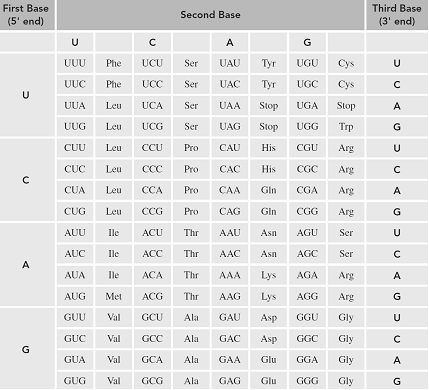
Concept explainers
Interpretation:
The base, codon, anticodon and the amino acid needed to complete a given table needs to be stated.
Concept Introduction:
The first step of the synthesis of proteins using the information in DNA is transcription.
During transcription, the synthesis of messenger RNA (mRNA) from DNA takes place.
Only one DNA strand is needed for RNA synthesis, thus the double helix of DNA unwinds during transcription. The strand used for the RNA synthesis is called template strand. The other strand (the non-template strand) is called informational strand and does not involve in the RNA synthesis.The informational strand of DNA is complementary to the template strand.
The informational strand of DNA is complementary to the template strand; meaning the base sequence of the informational strand consists of the complementary base sequence of the template strand.
complementary base pairs:
Adenine pairs with thymine (A−T base pair).
Cytosine pairs with guanine (C−G base pair).
In addition, the direction of the two strands in the same DNA have different directions. Therefore, if the template strand goes from 3' to 5', the informational strand goes from 5' to 3'.
The mRNA synthesized from transcription has a complementary sequence to the DNA template from which it is prepared. Since the informational strand of DNA is complementary to the template strand, the mRNA is an exact copy of the informational strand, the only exception is that the base T present in the informational strand is replaced by U on the RNA strand.
The information needed to prepare a polypeptide is in the mRNA strand. Each sequence of three
The below table gives the corresponding amino acid of each codon. Based on the codon sequence of the mRNA strand, the amino acid sequence of the polypeptide strand can be determined with the help of the table.

Transfer RNA (tRNA) brings specific amino acids to add to the synthesizing peptide chain. Each individual tRNA contains an anticodon of three nucleotides that is complementary to the codon in mRNA.
Want to see the full answer?
Check out a sample textbook solution
Chapter 22 Solutions
General, Organic, and Biological Chemistry - 4th edition
- 8. What is the major product of the following reaction? KMnO4 b a TOH OH OH C d OH "OH HO OH OHarrow_forwardChoose the right answerarrow_forward3. Draw ALL THE POSSBILE PRODUCTS AND THE MECHANISMS WITH ALL RESONANCE STRUCTURES. Explain using the resonance structures why the major product(s) are formed over the minor product(s). H₂SO4, HONO CHarrow_forward
- 7. Provide the product(s), starting material(s) and/or condition(s) required for the No mechanisms required. below reaction HO + H-I CI FO Br2, FeBr3 O I-Oarrow_forward6. Design the most efficient synthesis of the following product starting from phenot Provide the reaction conditions for each step (more than one step is required) and explain the selectivity of each reaction. NO MECHANISMS ARE REQUIRED. OH step(s) CIarrow_forwardWhat is the skeletal structure of the product of the following organic reaction?arrow_forward
- If a reaction occurs, what would be the major products? Please include a detailed explanation as well as a drawing showing how the reaction occurs and what the final product is.arrow_forwardWhat is the major organic product of the following nucleophilic acyl substitution reaction of an acid chloride below?arrow_forwardWould the following organic synthesis occur in one step? Add any missing products, required catalysts, inorganic reagents, and other important conditions. Please include a detailed explanation and drawings showing how the reaction may occur in one step.arrow_forward
- If a reaction occurs, what would be the major products? Please include a detailed explanation as well as a drawing showing how the reaction occurs and what the final product is.arrow_forwardPlease help me answer the following questions using the data I included. 1&2arrow_forwardAssign all the Protons in HNMRarrow_forward
 Chemistry for Today: General, Organic, and Bioche...ChemistryISBN:9781305960060Author:Spencer L. Seager, Michael R. Slabaugh, Maren S. HansenPublisher:Cengage Learning
Chemistry for Today: General, Organic, and Bioche...ChemistryISBN:9781305960060Author:Spencer L. Seager, Michael R. Slabaugh, Maren S. HansenPublisher:Cengage Learning General, Organic, and Biological ChemistryChemistryISBN:9781285853918Author:H. Stephen StokerPublisher:Cengage Learning
General, Organic, and Biological ChemistryChemistryISBN:9781285853918Author:H. Stephen StokerPublisher:Cengage Learning Organic And Biological ChemistryChemistryISBN:9781305081079Author:STOKER, H. Stephen (howard Stephen)Publisher:Cengage Learning,
Organic And Biological ChemistryChemistryISBN:9781305081079Author:STOKER, H. Stephen (howard Stephen)Publisher:Cengage Learning,- Chemistry: Matter and ChangeChemistryISBN:9780078746376Author:Dinah Zike, Laurel Dingrando, Nicholas Hainen, Cheryl WistromPublisher:Glencoe/McGraw-Hill School Pub Co
 Principles of Modern ChemistryChemistryISBN:9781305079113Author:David W. Oxtoby, H. Pat Gillis, Laurie J. ButlerPublisher:Cengage Learning
Principles of Modern ChemistryChemistryISBN:9781305079113Author:David W. Oxtoby, H. Pat Gillis, Laurie J. ButlerPublisher:Cengage Learning Chemistry: Principles and PracticeChemistryISBN:9780534420123Author:Daniel L. Reger, Scott R. Goode, David W. Ball, Edward MercerPublisher:Cengage Learning
Chemistry: Principles and PracticeChemistryISBN:9780534420123Author:Daniel L. Reger, Scott R. Goode, David W. Ball, Edward MercerPublisher:Cengage Learning





